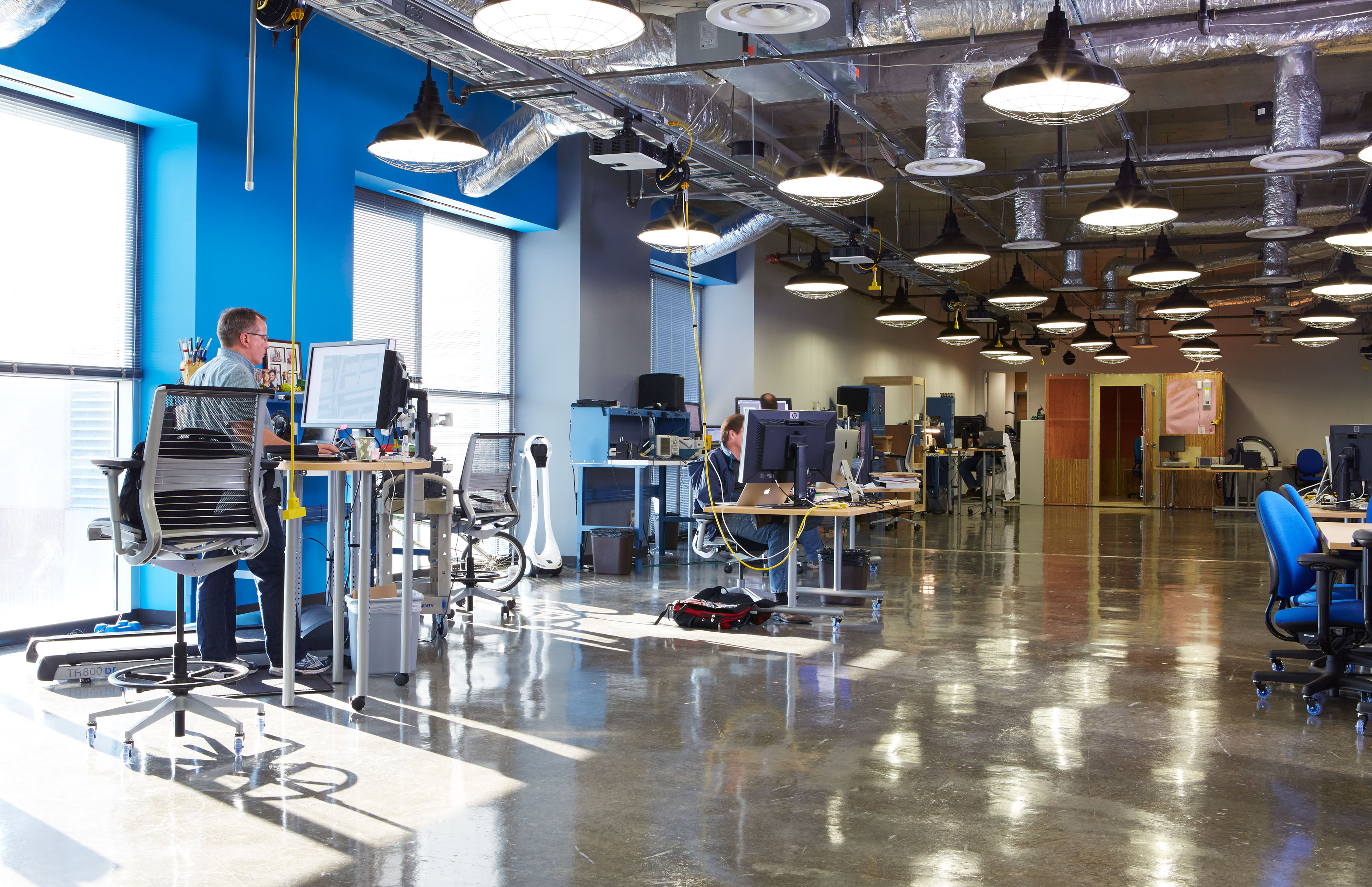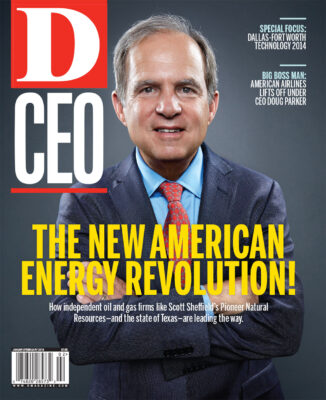
The AT&T Foundry idea began with one line inserted in one contract four years ago. It was a fairly standard contract between AT&T, Alcatel-Lucent, and Ericcson. Most of the details aren’t important. Something having to do with 4G service. What is important is that John Donovan, AT&T’s senior executive vice president of technology and network operations, decided he wanted to start an innovation center, and he needed corporate partners to do so. He put in one sentence in the contract stating that, oh yeah, in addition to the dozens of pages of technical stuff here, we want you to help us set up an innovation center.
Just like that, a culture-changing initiative was born. Well, not right away. Donovan had to farm out the task of establishing this nebulous “innovation center.” Defining what that meant, who would be involved, and which divisions would have oversight. Then, the new owner of this project, one rung below Donovan, had to delegate it. And so on.
The downstairs delegation Slinky finally stopped at Mike Berry. “I had a new job the next day,” says Berry. His first task was to get a handle on exactly what this foundry was, and what it would do. It wasn’t just a technical laboratory. AT&T already had that, an entire division of that, in fact. He needed to create a small special ops team that both understood the AT&T culture and yet could—heck, had to—operate independently of it. He had to create a small team that could help design new products for the company and its partners with the ingenuity of a trailblazing startup, and by doing so prove itself as a blueprint for change within the company itself.
“Yes, we wanted to innovate faster and find partners to do so with,” Berry says, “but the foundry idea was always also about changing the culture within AT&T. Our labs were always there, but we weren’t acting in Silicon Valley style: show, don’t tell; ask for forgiveness, not permission. That isn’t always possible within the confines of a huge corporate structure. But we were going to make sure it was possible in the foundries.”
To foster innovation (not just ideas, but products) in such narrow windows meant Berry had to create an environment where three characteristics were embraced:
Failure. It’s okay to fail, so long as you fail fast. That, Berry realized, was the key difference between innovation at big corporations—where multi-divisional pressure combines with budgetary inertia so that people continue to work on projects long after everyone realizes they are no longer salvageable—and at startups. No one cares, for instance, that Chicago-based 37signals once was just a middling web-design company, because it shuttered that business as soon as it realized it was fantastic at the next thing it tried (creating cloud-based enterprise software for small businesses). AT&T’s foundries needed to have the same ruthless self-critiquing with no blame being attached when time and money spent didn’t result in a product. That’s because the failures still provided lessons for the projects that succeed.
Independence. This makes failing fast possible. This makes decision-making immediate. This does not mean the foundries are isolated satellites. They realize the value of maintaining good relationships with other AT&T departments. In fact, part of the speed they provide is because they can collaborate with, say, the people at U-verse when they’re trying to design a new Android app that lets you receive caller-ID through your Wi-Fi to your set-top box. (That specific app—which differs from current systems by allowing the caller-ID to appear no matter the phone company—actually is being tested and prototyped in the Atlanta foundry, which focuses partly on Digital Life products.) Everyone on the team has to be comfortable making multiple judgment calls each day, for a variety of projects.
Flat management. The design is open, people can work at just about any station, and the managers are hard to spot. The teams are small—a half-dozen to a dozen engineers per foundry—so everyone has to be a project leader at different points in the process. Again, this is not the way companies the size of AT&T typically operate.
That’s why AT&T’s CTO has said, rightly, that the foundries that Berry started are “not your grandfather’s AT&T.” First, they’re all located in their own space, away from the large headquarters in their respective towns. The Plano offices, for example, are on the campus of Alcatel-Lucent, while the newest office in Atlanta recently went up in the high-tech area just off Georgia Tech’s campus. You notice the difference as soon as you set foot in the Plano offices. They are open, inviting, and loaded with high-tech gadgets. Even the security guard’s station is impressively wired (on his desk: an iPad, three computer screens, and four phones—two of them mobile, one of them in a Batman case). There’s a conference room with three large screens where employees can communicate in real time with other foundries, as though they’re in the same room. (It’s like Skype on steroids.) There are pull-down power boxes so you can plug in anywhere, anytime. Upstairs and down, most of the work furniture is on wheels so it can be moved or reconfigured as needed. There’s not a cubicle in sight.
The enterprise software folks downstairs may have the more impressive workspace, for two reasons. First, they’ve been there longer, so the space has a more lived-in quality (for example, the huge employee-drawn wall art of Gandalf). Second, it acts as a social center for the coding and start-up community of North Texas. That’s why there are couches in front of the 25-foot touch screen in the lounge area, where hackathons (coding contests open to outsiders) take place. That’s also why there are showers and lockers in the downstairs space, to accommodate the coders/hackers during their 48-hour weekend competitions. (Although the PR rep notes, “They don’t use the showers as often as you’d hope.”)
This is important in helping redefine the image of the company in the minds of tomorrow’s best and brightest tech stars. By having a place this impressive, this smart, this cool, the company is working to replace the idea that AT&T is a stodgy last-generation company with the idea that, hey, wouldn’t this be a kick-ass place to work? Which is a word you would never use in an AT&T story. But in an AT&T Foundry story, it seems as appropriate as the Gandalf wall art.

Let’s say, for example, you own a small garbage-collection company. You want to develop a device that goes on top of all your commercial-sized trash bins that will alert your drivers when they are nearly full, to make the process of emptying them more efficient. You submit your idea to the foundry in a two-page proposal (never more than two pages), and they choose to help you develop a proof of concept—a functioning prototype.
A small team from your company might set up shop in the upstairs foundry and be there for six to 12 weeks. First, you’d build your model out of Play-Doh, then whiteboard it out, then actually design it. Then you’d use the 3D printer in the shop (it’s not top-of-the-line, but at a quarter of a million bucks, it’ll get the job done) to design the components of your device. Meanwhile, experts on staff would work with you to design, test, and build the components that would be needed to communicate the garbage-bin levels to your truck-routing system. This would involve complicated tests for radio frequency configurations that all such mobile devices need to be FCC-compliant (the FCC handles its own testing for compliance at its own facility with its own quarter-million-dollar machines).
As this is going on, there is always an eye to scalability: it doesn’t pay to make one working prototype if it isn’t feasible to make 2 million of them in the same fashion. So the team also tries to solve any issues that could arise with packaging, delivering, or marketing. The goal being that, at the end of the process, the team can show a working model to ownership, and then the company can decide whether it wants to produce it. And, oh yeah, if they do want to do so, they’ll probably need AT&T’s help in some fashion along the way.
One real-world example of the foundry’s success so far: a new cloud-based, remote patient monitoring, Software-as-a-Service technology developed at the local foundry by AT&T, Ericsson, and Plano-based Vivify Health (formerly Intuitive Health).
“It’s a linear go-to-market model,” says Lee, the director of operations at the upstairs foundry, of this unique approach. “It costs less money, there are fewer pitfalls, and you get a product out the door faster. That’s our value.”
And, that approach is what you’d see most days if you took a tour of the facility. Except on Friday afternoons. That’s when Lee tells the engineers they need to work on personal projects. As a way to keep the mind generating creative solutions, and a way to keep everyone sane. Again, not a typical corporate directive. Lee shows off his current project: a device that can read the pH and chlorine levels of his pool and administer chemicals as needed to keep it in perfect balance. “I don’t have it yet,” he says. “But I’ll get there.”
Mike Berry suspects he’s led more than 1,000 tours of the AT&T Foundry offices in Plano. “We’re a little bit of a petting zoo,” he says, laughing. “They want to see the personnel and culture we have here.” Says Lee about the same tours he leads upstairs: “They always say the same thing. ‘Hey, we should do this, too.’ ” What they’re trying to capture is not the trappings of startups you see about the space—for example, the bicycles and scooters scattered around the upstairs machine-to-machine shop. They’re trying to instill in their companies the foundries’ sense of “engineered serendipity,” as Troy Meuninck, director of the Atlanta foundry, tells me. It’s the solutions that come from putting experts in a room, telling them to solve a problem, and then coming back three months later to see what they came up with.
“That’s why,” Meuninck says, “it’s not unusual for us to show an executive what we came up with, and [then] that person takes it back to his or her company, throws it on the table, and says, ‘You’ve been working on this for 18 months, and we’ve got nothing. I want this.’ ” As the program develops and continues to prove itself, Berry says, there is even more internal excitement about trying to make the foundries representative of, instead of different from, the company as a whole.
“We didn’t do everything right. We made mistakes,” he says. “Now, for example, we don’t take on an idea just because we love it, but because we see $50 million to $100 million ideas coming out of the work, either directly or indirectly. They have to make sense for our company. But it’s important that we become more like the best and brightest companies in the world, and the foundries help us do that. We’re infecting the company in the right way. The way that makes us leaner, faster, stronger.”
It’s an infection every company wants. The trick is building the right contamination system. One that, for example, has some Lego bricks. Maybe even some Play-Doh.






